- Jaguar Land Rover put "virtual eyes" on self-driving pods to interact with pedestrians on the road.
- The "eyes" are a combination of work between engineers and cognitive psychologists to research human trust in autonomous vehicles.
- Visit BusinessInsider.com for more stories.
Jaguar Land Rover put "virtual eyes" on its self-driving pods to measure how much trust people have in autonomous vehicles.
The autonomous pods run on a test street set and make direct "eye contact" with pedestrians to signal intent. Engineers then record the trust levels in the 500 test pedestrians before and after "eye contact" is made to discover if people have enough confidence in whether the car will stop for them.
Transform talent with learning that worksCapability development is critical for businesses who want to push the envelope of innovation.Discover how business leaders are strategizing around building talent capabilities and empowering employee transformation.Know More Studies have shown that 63% of pedestrians and cyclists say they'd feel less safe with autonomous vehicles on the road, according to the automakers. Jaguar Land Rover hopes that the research will provide insight into how much "information" self-driving cars should share to increase trust in the vehicles.
Read more: This custom tiny home on wheels was made from a Ford Transit van
The project plays off of the "second-nature" urge that pedestrians have when looking at the driver of a car before stepping out into the road.
"Understanding how this translates in tomorrow's more automated world is important," a research manager at Jaguar Land Rover's Future Mobility project, Pete Bennett, said in a prepared statement.
"We want to know if it is beneficial to provide humans with information about a vehicle's intentions or whether simply letting a pedestrian know it has been recognized is enough to improve confidence."
Check out the "eyes" that have engineers and cognitive psychologists working together:
 Saudi Arabia wants China to help fund its struggling $500 billion Neom megaproject. Investors may not be too excited.
Saudi Arabia wants China to help fund its struggling $500 billion Neom megaproject. Investors may not be too excited. I spent $2,000 for 7 nights in a 179-square-foot room on one of the world's largest cruise ships. Take a look inside my cabin.
I spent $2,000 for 7 nights in a 179-square-foot room on one of the world's largest cruise ships. Take a look inside my cabin. One of the world's only 5-star airlines seems to be considering asking business-class passengers to bring their own cutlery
One of the world's only 5-star airlines seems to be considering asking business-class passengers to bring their own cutlery Experts warn of rising temperatures in Bengaluru as Phase 2 of Lok Sabha elections draws near
Experts warn of rising temperatures in Bengaluru as Phase 2 of Lok Sabha elections draws near
 Axis Bank posts net profit of ₹7,129 cr in March quarter
Axis Bank posts net profit of ₹7,129 cr in March quarter
 7 Best tourist places to visit in Rishikesh in 2024
7 Best tourist places to visit in Rishikesh in 2024
 From underdog to Bill Gates-sponsored superfood: Have millets finally managed to make a comeback?
From underdog to Bill Gates-sponsored superfood: Have millets finally managed to make a comeback?
 7 Things to do on your next trip to Rishikesh
7 Things to do on your next trip to Rishikesh






 Next Story
Next Story